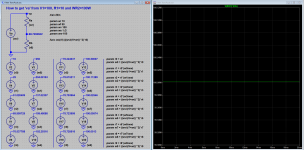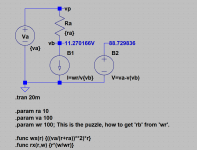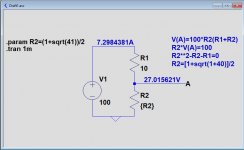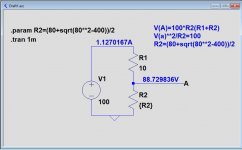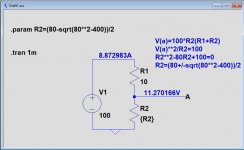Nothing wrong with Egghead its just an English word for Brainiac, just trying to be bit lively here.
And yes jou found the problem, the value of R2 or the current in R2 or the voltage across R2 needs to be calculated. It is a simple iteration, and it is easy to do in excel or comparable, even spice can doe it, but I do not know how to do it.
This all should be calculatable from the fact the R2 needs to dissipate 100 Watt's.
Ps I need a static result.
P.s. if any one is offended by me using eggheads then I sincerely apologize.
And yes jou found the problem, the value of R2 or the current in R2 or the voltage across R2 needs to be calculated. It is a simple iteration, and it is easy to do in excel or comparable, even spice can doe it, but I do not know how to do it.
This all should be calculatable from the fact the R2 needs to dissipate 100 Watt's.
Ps I need a static result.
P.s. if any one is offended by me using eggheads then I sincerely apologize.
Last edited:
Some question, I want to do a temperature plot for testing a vbe multiplier, can I exclude parts? if yes how.
I think the plot does not make sense if all parts are included, I need only two driver transistors and the sensor, diode or transistor.
Thanks.
I think the plot does not make sense if all parts are included, I need only two driver transistors and the sensor, diode or transistor.
Thanks.
Nothing wrong with Egghead its just an English word for Brainiac, just trying to be bit lively here.
And yes jou found the problem, the value of R2 or the current in R2 or the voltage across R2 needs to be calculated. It is a simple iteration, and it is easy to do in excel or comparable, even spice can doe it, but I do not know how to do it.
This all should be calculatable from the fact the R2 needs to dissipate 100 Watt's.
Ps I need a static result.
P.s. if any one is offended by me using eggheads then I sincerely apologize.
Interesting question. I probably do a guestimate and then a bunch of .step commends around that value and .meas the power to find the 100W point. But you probably want something smarter ;-)
Jan
Ohhh Jan you are so right, I did do that 'manually' for the post and that works, I am working on a sample like that, I will post later today, and yes smarter will be better 🙂
Actually, the iteration method works, but for me it looks... ugly? I think there must be something smart.
Hi
If I understand the question correctly...
I think that can be done using a dc sweep and '.measure' together with 'find/when'. Or...
When you know the value of the resistor, and the wattage you want to dissipate in it, multiply those and take the square root.
That will give you the voltage over the resistor that is needed to dissipate the wattage.
From that you can calculate the rest using ohm's law
Fx 100 watt into 8 ohms -> sqrt(8 * 100) ~ 28.3
Best regards
Jørgen
If I understand the question correctly...
I think that can be done using a dc sweep and '.measure' together with 'find/when'. Or...
When you know the value of the resistor, and the wattage you want to dissipate in it, multiply those and take the square root.
That will give you the voltage over the resistor that is needed to dissipate the wattage.
From that you can calculate the rest using ohm's law
Fx 100 watt into 8 ohms -> sqrt(8 * 100) ~ 28.3
Best regards
Jørgen
Good call, but, the value generated must be 'static' e.g. must be usable as a resistor or other part's value. So with 'static' I mean, not change its value during the simulation run, or, must be calculated before that the simulation starts.
The value calculated in my previous post will obey these criteria.
The value calculated in my previous post will obey these criteria.
Where come the 80 and the 400 from, the only numbers know in the 'puzzle' are 100V, 100W and 10Ohm.
See https://www.diyaudio.com/forums/sof...ltxvii-beginner-advanced-222.html#post6311790
See https://www.diyaudio.com/forums/sof...ltxvii-beginner-advanced-222.html#post6311790
Last edited:
Hans, it escapes me completely. The correct answer is know and shown.
I only would like a non iterating numerical solution that leads to a static answer.
> V(a)=100*R2(R1+R2)
Will not work while R2 is unknown
> V(a)^2/R2=100
Will not work while R2 is unknown
> Substituting V(a) in the first equation gives:
> R2^2-80R2+100=0
Will not work while R2 is unknown
> Solving this quadratic equation gives
> R2=(80+/-sqrt(80^2-400))/2
How do the numbers 80 and 400 come into existence?
Please note that the exercise/question aims to find R2 or I(R2) or the voltage at the top of R2, any will do.
See also https://www.diyaudio.com/forums/sof...ltxvii-beginner-advanced-224.html#post6312139
and earlier.
I only would like a non iterating numerical solution that leads to a static answer.
> V(a)=100*R2(R1+R2)
Will not work while R2 is unknown
> V(a)^2/R2=100
Will not work while R2 is unknown
> Substituting V(a) in the first equation gives:
> R2^2-80R2+100=0
Will not work while R2 is unknown
> Solving this quadratic equation gives
> R2=(80+/-sqrt(80^2-400))/2
How do the numbers 80 and 400 come into existence?
Please note that the exercise/question aims to find R2 or I(R2) or the voltage at the top of R2, any will do.
See also https://www.diyaudio.com/forums/sof...ltxvii-beginner-advanced-224.html#post6312139
and earlier.
Last edited:
Hi again.
To calculate VA we need to know R2.
To calculate R2, we would need the voltage over R1 or the current through R1. But we only have wattage dissipated in R2.
I might be wrong, but I am not sure it is possible to solve this one with the values given.
To calculate VA we need to know R2.
To calculate R2, we would need the voltage over R1 or the current through R1. But we only have wattage dissipated in R2.
I might be wrong, but I am not sure it is possible to solve this one with the values given.
Onemangang, as shown before the calculation can be solved, and is, without knowing the value of R2. Please read the previous posts.
I only would like a non iterating numerical solution that leads to a static answer.
> To calculate VA we need to know R2.
No you do now.
> To calculate R2, we would need the voltage over R1 or the current through R1. But we only have wattage dissipated in R2.
No is not needed.
> I might be wrong, but I am not sure it is possible to solve this one with the values given.
Yes it is posible, it can be solved.
What is the problem, to my opinion the question is clear, and the solvability of the problem is proven.
I only would like a non iterating numerical solution that leads to a static answer.
> To calculate VA we need to know R2.
No you do now.
> To calculate R2, we would need the voltage over R1 or the current through R1. But we only have wattage dissipated in R2.
No is not needed.
> I might be wrong, but I am not sure it is possible to solve this one with the values given.
Yes it is posible, it can be solved.
What is the problem, to my opinion the question is clear, and the solvability of the problem is proven.
Last edited:
Hi
Yes, we agree, through iteration of sorts. But I don't think it's possible the way you want/need it.
I might be wrong though ��
Yes, we agree, through iteration of sorts. But I don't think it's possible the way you want/need it.
I might be wrong though ��
Onemangaug, now that is clear, so we are on the same page, using iterations it can be solved, the question is still there:
Does anyone know a non-iterating way of solving this?
Does anyone know a non-iterating way of solving this?
Does anyone know a non-iterating way of solving this?
There are 2 solutions, I gave you the answers to both.
The comment on the right in Blue was just to confirm your premises, resp 100V, 10R and 100Watt for R2.
Solving these equations gives R2^2-80R2+100=0
Look here how to solve a quadratic equation:
Quadratic Equation Solver
Using this gives
.param R2=(80+sqrt(80^2-400))/2 and
.param R2=(80-sqrt(80^2-400))/2
This the non iterating way of solving your problem.
Hans
Last edited:
- Home
- Design & Build
- Software Tools
- Installing and using LTspice IV (now including LTXVII), From beginner to advanced
